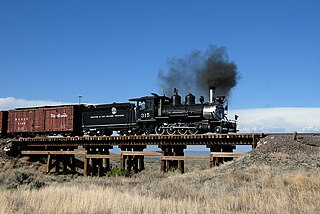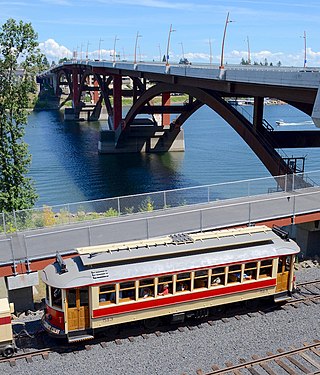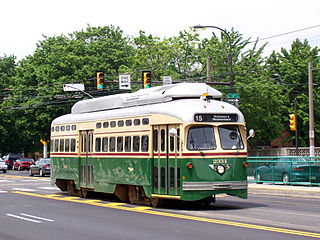
Machu Picchu is a 15th-century Inca citadel located in the Eastern Cordillera of southern Peru on a 2,430-meter (7,970 ft) mountain ridge. Often referred to as the "Lost City of the Incas", it is the most familiar icon of the Inca Empire. It is located in the Machupicchu District within Urubamba Province above the Sacred Valley, which is 80 kilometers (50 mi) northwest of Cusco. The Urubamba River flows past it, cutting through the Cordillera and creating a canyon with a tropical mountain climate.

A heritage railway or heritage railroad is a railway operated as living history to re-create or preserve railway scenes of the past. Heritage railways are often old railway lines preserved in a state depicting a period in the history of rail transport.

A railcar is a self-propelled railway vehicle designed to transport passengers. The term "railcar" is usually used in reference to a train consisting of a single coach, with a driver's cab at one or both ends. Some railway companies, such as the Great Western, termed such vehicles "railmotors".

The Pullman Company, founded by George Pullman, was a manufacturer of railroad cars in the mid-to-late 19th century through the first half of the 20th century, during the boom of railroads in the United States. Through rapid late-19th century development of mass production and takeover of rivals, the company developed a virtual monopoly on production and ownership of sleeper cars. During a severe economic downturn, the 1894 Pullman Strike by company workers proved a transforming moment in American labor history. At the company's peak in the early 20th century, its cars accommodated 26 million people a year, and it in effect operated "the largest hotel in the world". Its production workers initially lived in a planned worker community named Pullman, Chicago.

Conservation and restoration of rail vehicles aims to preserve historic rail vehicles.

The Willamette Shore Trolley is a heritage railroad or heritage streetcar that operates along the west bank of the Willamette River between Portland and Lake Oswego in the U.S. state of Oregon. The right-of-way is owned by a group of local-area governments who purchased it in 1988 in order to preserve it for potential future rail transit. Streetcar excursion service began operating on a trial basis in 1987, lasting about three months, and regular operation on a long-term basis began in 1990. The Oregon Electric Railway Historical Society has been the line's operator since 1995.
The St. Louis Car Company was a major United States manufacturer of railroad passenger cars, streetcars, interurbans, trolleybuses and locomotives that existed from 1887 to 1974, based in St. Louis, Missouri.

The San Diego Electric Railway (SDERy) was a mass transit system in Southern California, United States, using 600 volt DC streetcars and buses.

The J. G. Brill Company manufactured streetcars, interurban coaches, motor buses, trolleybuses and railroad cars in the United States for almost ninety years, making it the longest-lasting trolley and interurban manufacturer. At its height, Brill was the largest manufacturer of streetcars and interurban cars in the US and produced more streetcars, interurbans and gas-electric cars than any other manufacturer, building more than 45,000 streetcars alone.

Canadian Car and Foundry (CC&F), also variously known as "Canadian Car & Foundry" or more familiarly as "Can Car", was a manufacturer of buses, railway rolling stock, forestry equipment, and later aircraft for the Canadian market. CC&F history goes back to 1897, but the main company was established in 1909 from an amalgamation of several companies and later became part of Hawker Siddeley Canada through the purchase by A.V. Roe Canada in 1957. Today the remaining factories are part of Alstom after its acquisition of Bombardier Transportation completed in 2021.

The Fort Collins Municipal Railway operated streetcars in Fort Collins, Colorado, from 1919 until 1951. Since 1984, a section of one of the former routes has been in operation as a seasonal heritage streetcar service, under the same name, running primarily on Spring and Summer weekends. The heritage service is operated by volunteers from the Fort Collins Municipal Railway Society (FCMRS). The streetcar in use on the heritage line, Birney "Safety" Streetcar No. 21, is listed on the National Register of Historic Places.

The McKinney Avenue Transit Authority (MATA), a non-profit organization, operates the M-Line Trolley in Dallas, Texas. In operation since 1989, it is an example of a heritage streetcar running historic cars. The M-Line Trolley operates 7 days per week, 365 days per year. Since 2002, the M-Line Trolley is free to the public, thanks to donations and a joint operating subsidy received from Dallas Area Rapid Transit (DART) and the Uptown Improvement District. The main stretch of the line runs along McKinney Avenue in Uptown between West Village and Klyde Warren Park / Dallas Arts District. The M-Line Trolley connects to the DART light rail system at CityPlace/Uptown on the northern end and St. Paul on the southern end.

PeruRail is a railway operator providing tourist, freight, and charter services in southern Peru. It was founded in 1999 by two Peruvian entrepreneurs and the British company Sea Containers.

The Fort Smith Trolley Museum is a streetcar and railroad museum in Fort Smith, in the U.S. state of Arkansas, which includes an operating heritage streetcar line. The museum opened in 1985, and operation of its streetcar line began in 1991. Four vehicles in its collection, a streetcar and three steam locomotives, are listed on the National Register of Historic Places (NRHP). The now approximately three-quarters-mile-long (1.2 km) streetcar line also passes four NRHP-listed sites, including the Fort Smith National Historic Site, the Fort Smith National Cemetery, the West Garrison Avenue Historic District and the 1907 Atkinson-Williams Warehouse Building, which now houses the Fort Smith Museum of History.

Streetcars or trolley(car)s were once the chief mode of public transit in hundreds of North American cities and towns. Most of the original urban streetcar systems were either dismantled in the mid-20th century or converted to other modes of operation, such as light rail. Today, only Toronto still operates a streetcar network essentially unchanged in layout and mode of operation.

The Galveston Island Trolley is a heritage streetcar network in Galveston, Texas, United States. As of late 2006, the total network length was 6.8 miles (10.9 km) with 22 stations. The Galveston Island Trolley is operated by Island Transit. The rail system reopened in 2021, after having been out of service for 13 years following severe damage caused by Hurricane Ike in 2008. Subsequent to the 2008 closure, the Federal Emergency Management Agency (FEMA) and the Federal Transit Administration agreed to fund repairs. In January 2017, a contract was approved to restore three of the trolleys at a cost of $3.8 million. At that time, the trolleys were expected to be ready to return to service in 2018, but the date was later postponed to 2019 and later to 2021. By November 2020, two reconditioned trolleys had returned to Galveston. The line reopened for service in October 2021, limited to three days a week for now.

The Lake Shore Electric Railway was an attempt to start an electric railway museum in Cleveland, Ohio.

The Wickham trolley was a railway engineering personnel carrier built by D. Wickham & Co of Ware, Hertfordshire. This long established firm introduced their rail trolley in 1922 as a lightweight track inspection and maintenance vehicle. This was a success and production of rail trolleys and railcars for inspection and maintenance continued until 1990.

The PCC II is a series of upgraded PCC streetcars used by the Southeastern Pennsylvania Transportation Authority, in Philadelphia, Pennsylvania, for its Route 15-Girard Avenue.
Belmond Hiram Bingham is a luxury train operating day return trips from Poroy station outside Cusco to Aguas Calientes, the station for Machu Picchu in Peru.



















